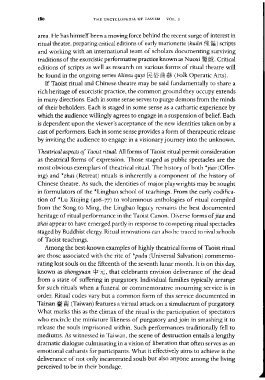Page 220 - The Encyclopedia of Taoism v1_A-L
P. 220
180 THE ENCYCLOPEDIA OF TAOISM VOL. I
area. He has himself been a moving force behind the recent surge of interest in
ritual theatre, preparing critical editions of early marionette (kuilei f%!. flIMI) scripts
and working with an international team of scholars documenting surviving
traditions of the exorcistic performative practice known as Nuoxi i~!t1x. Critical
editions of scripts as well as research on various forms of ritual theatre will
be found in the ongoing series Minsu quyi ~ 1ft ltlJ ~ (Folk Operatic Arts).
If Taoist ritual and Chinese theatre may be said fundamentally to share a
rich heritage of exorcistic practice, the common ground they occupy extends
in many directions. Each in some sense serves to purge demons from the minds
of their beholders. Each is staged in some sense as a cathartic experience by
which the audience willingly agrees to engage in a suspension of belief. Each
is dependent upon the viewer's acceptance of the new identities taken on by a
cast of performers. Each in some sense provides a form of therapeutic release
by inviting the audience to engage in a visionary journey into the unknown.
Theatrical aspects of Taoist ritual. All forms of Taoist ritual permit consideration
as theatrical forms of expression. Those staged as public spectacles are the
most obvious exemplars of theatrical ritual. The history of both *jiao (Offer-
ing) and *zhai (Retreat) rituals is inherently a component of the history of
Chinese theatre. As such, the identities of major playwrights may be sought
in formulators of the *Lingbao school of teachings. From the early codifica-
tion of *Lu Xiujing (406-77) to voluminous anthologies of ritual compiled
from the Song to Ming, the Lingbao legacy remains the best documented
heritage of ritual performance in the Taoist Canon. Diverse forms of jiao and
zhai appear to have emerged partly in response to competing ritual spectacles
staged by Buddhist clergy. Ritual innovations can also be traced to rival schools
of Taoist teachings.
Among the best-known examples of highly theatrical forms of Taoist ritual
are those associated with the rite of *pudu (Universal Salvation) commemo-
rating lost souls on the fifteenth of the seventh lunar month. It is on this day,
known as zhongyuan r:p 5I:, that celebrants envision deliverance of the dead
from a state of suffering in purgatory. Individual families typically arrange
for such rituals when a funeral or commemorative mourning service is in
order. Ritual codes vary but a common form of this service documented in
Tainan ltl¥J (Taiwan) features a virtual attack on a simulacrum of purgatory.
What marks this as the climax of the ritual is the participation of spectators
who encircle the miniature likeness of purgatory and join in smashing it to
release the souls imprisoned within. Such performances traditionally fell to
mediums. As witnessed in Taiwan, the scene of destruction entails a lengthy
dramatic dialogue culminating in a vision of liberation that often serves as an
emotional catharsis for participants. What it effectively aims to achieve is the
deliverance of not only incarcerated souls but also anyone among the living
perceived to be in their bondage.

